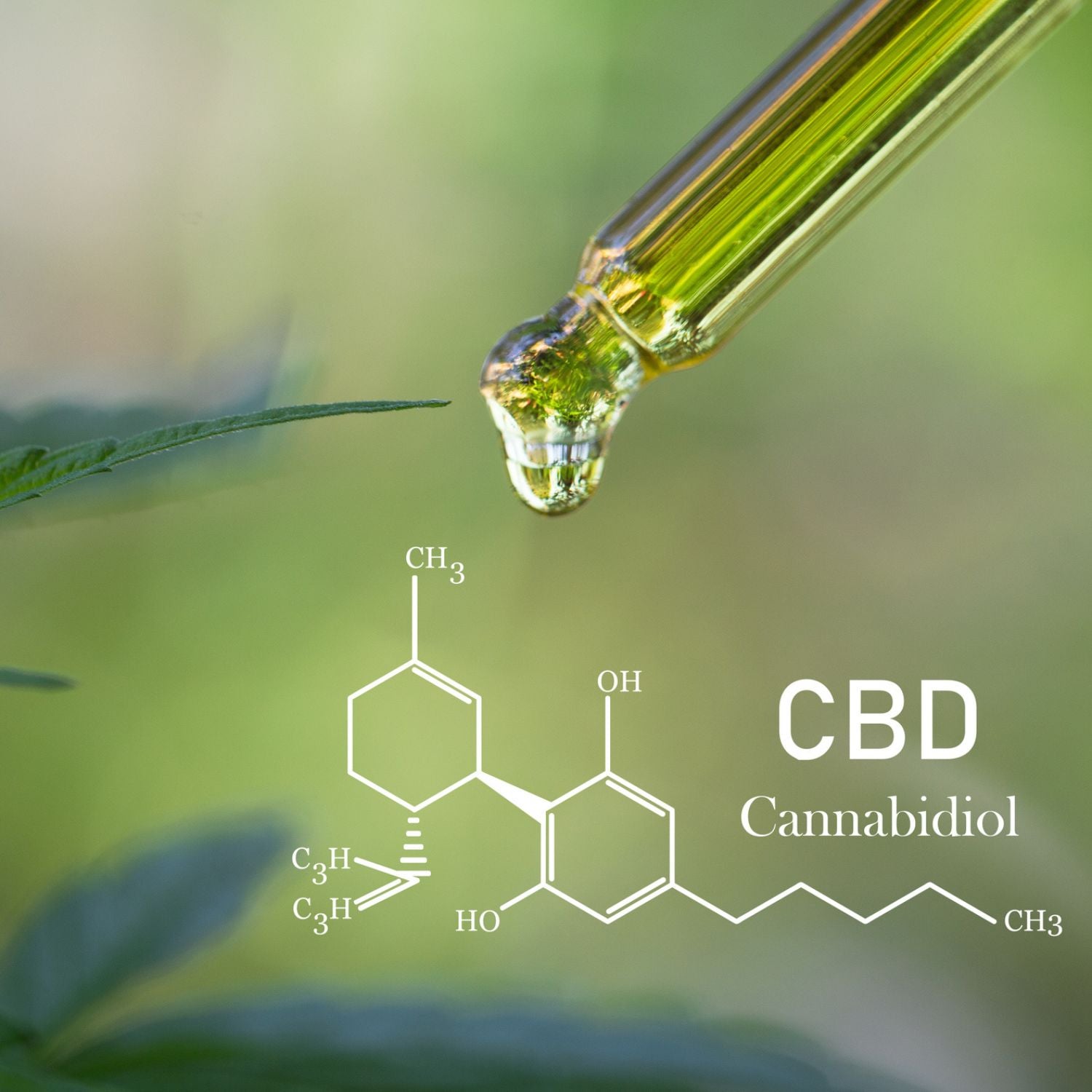The Endocannabinoid System (ECS)
The ECS plays a crucial role in regulating various physiological functions, including pain, mood, appetite, and inflammation. It is composed of cannabinoid receptors (CB1 and CB2), endocannabinoids (such as anandamide and 2-AG), and enzymes that synthesize and degrade these molecules. CBD primarily interacts with CB1 receptors in the central nervous system and CB2 receptors found in peripheral tissues, impacting immune and inflammatory responses. Endocannabinoids are naturally produced by the body to maintain balance within the ECS, while cannabinoids are compounds found in cannabis plants (like THC and CBD) that can also bind to ECS receptors.
Cannabinoids are naturally occurring compounds found in cannabis plants. The two most well-known cannabinoids are THC (tetrahydrocannabinol) and CBD (cannabidiol), but there are over 100 different cannabinoids in total. These compounds interact with the endocannabinoid system (ECS) in the human body, influencing receptors that regulate various physiological processes such as mood, pain sensation, appetite, and immune response.
The endocannabinoid system has become a focus for studies of pharmacotheray.

What is CBD?
CBD (cannabidiol) is a naturally occurring compound found in the cannabis plant. Unlike THC, it doesn’t produce psychoactive effects, making it attractive for therapeutic uses. Studies indicate potential benefits for pain relief, anxiety reduction, and anti-inflammatory effects, without the "high" associated with marijuana.

CBD EXPLAINED

Key Differences Between Hemp, CBD, and Marijuana
Hemp: A variety of the Cannabis sativa plant, hemp contains high levels of CBD and less than 0.3% THC, which makes it non-psychoactive and federally legal under the 2018 Farm Bill.
CBD: Extracted primarily from hemp and used in various products like oils, tinctures, and creams.
Marijuana: Contains higher levels of THC, the psychoactive compound responsible for the “high.”
Indicated Uses of CBD
CBD shows promise in treating conditions like chronic pain, anxiety, epilepsy (e.g., Lennox-Gastaut syndrome), and insomnia. Preliminary research also indicates potential benefits for inflammatory diseases, PTSD, and neuroprotective applications.
The Entourage Effect
It is important to understand the significance of the entourage effect when selecting what type of CBD to purchase. The entourage effect refers to the synergistic interaction of the various compounds found in the cannabis plant, including cannabinoids (like CBD and THC), terpenes, and flavonoids. When these compounds work together, they enhance the therapeutic effects of the plant beyond what any one compound, such as CBD or THC, could achieve on its own. This phenomenon is believed to increase the overall effectiveness of cannabis-based treatments, providing broader health benefits than isolated compounds like pure CBD (CBD Isolate).

Full Spectrum
Contains a whole host of naturally occurring cannabinoids, including trace amounts of THC (less than 0.3%), along with other beneficial compounds like terpenes and flavonoids. This creates the "entourage effect," where compounds work synergistically.

Broad Spectrum
Similar to Full Spectrum, but with no detectable THC, offering benefits without the risk of psychoactive effects.

CBD Isolate
Pure CBD with no other cannabinoids, terpenes, or THC.
Different Forms of CBD Use

Oral
Capsules, oils, and edibles offer convenient dosing but come with slower onset and lower bioavailability due to digestive breakdown.

Sublingual
Tinctures absorbed under the tongue provide faster effects, bypassing first-pass metabolism.

Topical
Creams and balms target localized areas of pain or inflammation.

Inhalation
Vaporizers or smoking CBD-rich flower offer rapid absorption but may have long-term lung risks.

Proper Dosing of CBD
Dosing is highly individualized and depends on the patient's body weight, condition, and form of CBD. Start with a low dose (e.g., 10 mg daily) and increase gradually. Studies suggest that effective doses typically range from 10-100 mg daily, depending on the indication.
Product labels often have to meet strict requirements by a state. In Utah, the state requires that the number on the front be the total CBD contained in the product (as opposed to amount of CBD per serving).On the back, you can often find a supplement panel that will list how dosages there are and how much CBD per dose. For example, you might see a product on the shelf that says 2,000mg of CBD prominently on the front of the label. The 2,000mg is the total amount of CBD in the bottle and each serving contains 66mg of CBD. If you want to verify the amount of CBD per dose, check for third-party lab results provided by the brand.
Discussing CBD with Patients
When discussing CBD with patients, provide balanced information about its benefits and risks. Emphasize the importance on of consistency to achieve maximum benefits. Many people report needing to use the products consistently for 2-4 weeks before they noticed any changes. Encourage them to report any side effects and keep a usage log to track symptoms and outcomes.
Drug Interactions
CBD is known to inhibit the liver’s cytochrome P450 enzyme system, which is responsible for metabolizing many prescription medications. Careful monitoring is required when patients are using CBD alongside medications like blood thinners (e.g., warfarin), anti-epileptics, or immunosuppressants.
Side Effects
CBD is generally well tolerated and has a generally favorable safety profile. Some potential side effects such as dry mouth, drowsiness, diarrhea, and changes in appetite may occur. High doses may result in more pronounced sedation. As with any product, it is important that users obtained CBD from a safe source. It is advised that they use a product that has been tested by an accredited third-party lab.

Legalities of CBD
CBD derived from hemp is federally legal if it contains less than 0.3% THC. However, state laws may vary, and it’s important for clinicians to understand their state's regulations. CBD cannot be marketed as a treatment for any medical condition unless approved by the FDA (e.g., Epidiolex for epilepsy). Some states, such as Utah, require that all CBD products be registered with them before selling in the state. You can find Utah's product registry here.
What Should Consumers Look for in CBD Products?
Advise patients to look for third-party lab-tested products with clear labeling of CBD content, THC levels, and the absence of harmful contaminants (e.g., pesticides, heavy metals). Full-spectrum products may offer enhanced effects due to the "entourage effect," but CBD isolates are preferred for those seeking THC-free options.
Look for a Certificate of Analysis (COA)
Credible brands will post third-party lab results from a credible lab. Some states require that there be a link or qr code visible on each product containing CBD. Make sure that the lab results match the name of the product you are looking at. You can see a sample COA here.
Ensure accurate CBD content labeling
Beware of of products that do not clearly state the amount of CBD on their products. In the state of Utah, the front of the bottle needs to contain the total mg of CBD contained in the product. For example, a tincture might say 2,000mg of CBD on the front of the bottle, denoting that there is 2,000mg total in the bottle and not per serving.
Confirm THC levels are compliant with legal limits (less than 0.3%)
Under the Farm Act, a product must contain less than 0.3% to be considered CBD. If the label does not state the amount of THC, check for a valid COA on the company website. The amount of THC can be found under Cannabinoids in the lab testing.
Check for contaminants (e.g., pesticides, solvents, heavy metals)
Hemp is incredible at bioaccumulation, meaning it can absorb pesticides, solvents, and heavy metals from soil and the air. For your safety, products should be checked by an accredited third-party lab to make sure it is clean and safe for use. These results should be posted in a COA by the brand.
Review product ingredients and storage instructions
Be sure to read labels to make sure it contains dosages and directions on how to use. Most CBD products should be stored in a dry location out of direct sunlight.
Avoid medical claims unless FDA-approved
Be cautious of any CBD product that promises to diagnose, treat, cure or prevent any disease.
CBD
SCIENCE
Hare are just a few research articles about CBD.
Clinicians' Guide to Cannabidiol and Hemp Oils
Summary: This guide provides a comprehensive review of cannabidiol (CBD) and hemp oils, their therapeutic potential, and the science behind their effects. It emphasizes CBD’s non-intoxicating nature, distinguishing it from THC, and highlights its use in conditions like epilepsy, chronic pain, and opioid addiction. The guide addresses the legal landscape and variability in product quality, stressing the importance of clinicians guiding patients toward safe, well-regulated CBD products due to the lack of consistent labeling and regulation in the industry.
Link: Click here to view the original source.
Citation: Clinicians’ Guide to Cannabidiol and Hemp Oils, VanDolah, Harrison J. et al.Mayo Clinic Proceedings, Volume 94, Issue 9, 1840 - 1851
Cannabidiol Inhibits SARS-CoV-2 Replication and Promotes the Host Innate Immune Response
Summary: Cannabidiol from the cannabis plant has potential to prevent and inhibit SARS-CoV-2 infection.
CBD and its metabolite, 7-OH-CBD, but not congeneric cannabinoids, potently block SARS-CoV-2 replication in lung epithelial cells. CBD acts after cellular infection, inhibiting viral gene expression and reversing many effects of SARS-CoV-2 on host gene transcription. CBD induces interferon expression and up-regulates its antiviral signaling pathway. A cohort of human patients previously taking CBD had significantly lower SARSCoV-2 infection incidence of up to an order of magnitude relative to matched pairs or the general population.
Link: Click here to view the original source.
Citation: Elms, L., Shannon, S., Hughes, S., & Lewis, N. (2019). Cannabidiol in the Treatment of Post-Traumatic Stress Disorder: A Case Series. Journal of alternative and complementary medicine (New York, N.Y.),25(4), 392–397. https://doi.org/10.1089/acm.2018.0437
Cannabidiol in the Treatment of Post-Traumatic Stress Disorder: A Case Series
Summary: Administration of oral CBD in addition to routine psychiatric care was associated with PTSD symptom reduction in adults with PTSD. CBD also appeared to offer relief in a subset of patients who reported frequent nightmares as a symptom of their PTSD. Additional clinical investigation, including double-blind, placebo-controlled trials, would be necessary to further substantiate the response to CBD that was observed in this study.
Link: Click here to view the original source.
Citation: Elms, L., Shannon, S., Hughes, S., & Lewis, N. (2019). Cannabidiol in the Treatment of Post-Traumatic Stress Disorder: A Case Series. Journal of alternative and complementary medicine (New York, N.Y.),25(4), 392–397. https://doi.org/10.1089/acm.2018.0437
Cannabidiol as a Potential Treatment for Anxiety Disorders
Summary: Preclinical evidence conclusively demonstrates CBD’s efficacy in reducing anxiety behaviors relevant to multiple disorders, including PTSD, GAD, PD, OCD, and SAD, with a notable lack of anxiogenic effects. CBD’s anxiolytic actions appear to depend upon CB1Rs and 5-HT1ARs in several brain regions; however, investigation of additional receptor actions may reveal further mechanisms. Human experimental findings support preclinical findings, and also suggest a lack of anxiogenic effects, minimal sedative effects, and an excellent safety profile. Current preclinical and human findings mostly involve acute CBD dosing in healthy subjects, so further studies are required to establish whether chronic dosing of CBD has similar effects in relevant clinical populations. Overall, this review emphasizes the potential value and need for further study of CBD in the treatment of anxiety disorders.
Link: Click here to view the original source.
Citation: Blessing, E. M., Steenkamp, M. M., Manzanares, J., & Marmar, C. R. (2015). Cannabidiol as a Potential Treatment for Anxiety Disorders. Neurotherapeutics : the journal of the American Society for Experimental NeuroTherapeutics, 12(4), 825–836. https://doi.org/10.1007/s13311-015-0387-1






